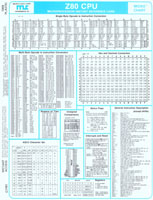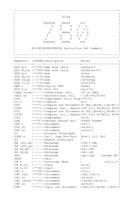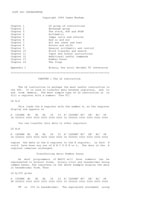






(1986)_tn.jpg)
|
"30 Customized Microprocessor Projects" By Delton T. Horn Copyright 1986, by TAB BOOKS (ISBN - 0-8306-0705-6) Despite the seemingly generic name, this book covers, exclusively, Z80 hardware projects. Here is what the 300-page book contains:
Table of Contents
Introduction
List of Projects
Section I - The Basics
Chapter 1 - The Basics of Circuit Design
Chapter 2 - Digital Basics
Chapter 3 - The CPU
Chapter 4 - Semiconductor Memory
Chapter 5 - Interfacing
Section II - Projects
Chapter 6 - CPU Breadboard
Chapter 7 - EPROM Programmer
Chapter 8 - Timer / Automation Systems
Chapter 9 - Security Systems
Chapter 10 - Test Equipment
Chapter 11 - Robots
Chapter 12 - Sound Synthesis
Chapter 13 - Programming
Appendices
Appendix A - The Z80 Instruction Set
Appendix B - Hexadecimal Instruction Codes for the Z80
Appendix C - Sample Computer Programs
Index
|
_tn.jpg)
|
"ASM83 Guru - TI-83 ASM Tutorials" By James Matthews. ASMGuru is your one-stop file to learning 83 ASM! This help file should be just about all you need to learn ASM proficiently (and time, of course), as I've written over 50 tutorials, and included a large reference section for you to look at. This is a zipped Windows Help File. |
_tn.jpg) |
"Introduction to Z80 Assembler" By James Hollidge. This document will give an introduction to all aspects of the Z80 assuming no knowledge of programming. |
[html]_tn.jpg) |
"Learn TI-83 Plus Assembly In 28 Days v2.0" By Sean McLaughlin This html guide is intended so that people who have little or no experience in assembly can learn how to make calculator programs. This is guide is intended for TI-83 calculator users, but other Z80 users will probably get some use out of it as well. There are two versions of the document: an HTML and Windows Compiled Help File. If you would rather use the Windows Compiled Help file than the html file, you can download that here:
|
(Rodnay Zaks)(Sybex)_tn.jpg) |
"Programming the Z-80" By Rodnay Zaks. Copyright 1980, Sybex. (ISBN 089588-057-1) 624 pages. From the back of the book: "Programming the Z80" has been designed both as an educational text and as a self-contained reference book. As such, it can be used as a complete introductory book on programming ranging from the basic concepts to advanced data structures manipulations. It also contains a comprehensive description of all the Z80 instructions as well as its internal operation, and should provide a comprehensive reference for the reader who is already familiar with the principles of programming, but wishes to learn the Z80. This book is the result of extensive experience by the author in the field of education and programming. As such, it has been designed to be clear and easy to read. All concepts are explained in simple yet precise terms, building progressively towards more complex techniques. The reader will gain not only an understanding of programming in the language of the Z80 rut also a detailed understanding of the way a microprocessor such as the Z80 actually executes instructions. The reader will follow the flow of execution between the various registers and along the buses. This is indispensable for effective programming at machine level in the world of microprocessors because programming is not just the skill of coding in algorithm into a programming language but also the art of designing appropriate data structures. An extensive chapter on data structures is presented which both introduces the concepts and actual application algorithms. The reader will find there lists, tables, binary trees, and the required algorithms. After reading this book, the reader should have acquired all the basic skills required to program not just at the elementary level, but in most practical cases. |
_tn.jpg) |
"The Undocumented Z80 Documented" By Sean Young. Version 0.91, September 18, 2005. Documents all of the undocumented Z80 commands. Written by an emulator author. |
(Lance A Leventhal)[Chapter 3 - The Z80 Instruction Set]_tn.jpg) |
"Z80 Assembly Language Programming" By Lance A Leventhal 1979. This is just ONLY chapter 3 which covers the Z80 assembly language instruction set. It is a good reference. If you can get your hands on the book then you should pick it up. |
(Lance A Leventhal)(Osborne)_tn.jpg) |
"Z80 Assembly Language Subroutines" By Lance A Leventhal 1983, ISBN 0-931988-91-8 This is the complete 512 page book. The back cover of the book notes: Save valuable programming time with this collection of more than 40 useful subroutines. Each routine has been documented, tested, and debugged, and is ready to use immediately. "Z80 Assembly Language Subroutines" provides you with:
|
_tn.jpg) |
"Z80 Assembly Optimization Tricks" By Adam Ziemba and Leif Astrand In hopes of getting Z80 Assembly programmers to write more efficient programs, this list of optimization tricks has been comprised. It is suggested that you memorize these tricks so that you can become quick and adept at writing efficient assembly programs. (15 Pages) |
(Zilog)(UM008005)_tn.jpg) |
"Z80 CPU User Manual" By Zilog User Manual 008011 (Document No. UM008011-0816). August 2016. This is Zilog's official "Z80 CPU User Manual." Recommended. An older verson of this manual from February 2002 is also available here:
|
 |
Z80 CPU Microprocessor Instant Reference Card By Micro-Logic Corp Published 1981 This 8 1/2" x 11" double-side plastic Z80 reference card sums up just about all the programming information needed for the Z80 microprocessor. The regular link is a B&W scan of the original card. This will probably work best for most people under most circumstances. However, some parts of the reference card were meant to be used in color. Thus, other scans are available:
|
 |
"Z80 Instructions, Sorted by Opcode" By Sean Young. November 29, 1997. This should be the complete list of all the opcodes of the Zilog Z80. |
(J G Harston)_tn.jpg) |
"Z80 Opcode List" By J.G. Harston. September 9, 1997. Full Z80 Opcode List Including Undocumented Opcodes. Here is an alternate version of the list. This one isn't dated, nor is there anyone that claims it as their own work: |
 |
"Z80 Instruction Set Summary" Compiled by Simon Owen. |
 |
"Z80 MICROPROCESSOR Instruction Set Summary" This is a very neat, compressed setup that can be printed in just four pages. |
 |
"ZINT Z80 Interpreter Assembler Handbook" By James Moxham. Introduction to the Z80 Instruction Set based on ZINT (the Z80 Interpreter). This has Z80 opcodes with detailed usage. A text version of the html link is also available. It might be preferable if you want to print the document.
|
(1980)_tn.jpg) |
"Z-80 Microcomputer Design Projects" By William Barden Jr. Copyright 1980, Howard W. Sams & Co., Inc. (ISBN 0-672-21682-5) From the Preface: "This book provides a step-by-step guide in building a complete microcomputer, the EZ-80, and for implementing a number of different applications. Although some kit-building experience may be of help, every attempt has been made to provide a trouble-free guide to construction even for the neophyte. The applications range from a music synthesizer that will play one-voice musical scores with special effects, to a Morse code generator that generates code for practice or transmission, to a telephone dialer, to a timer that times external events over 100 days. Each application is fully documented in detail. For those readers who are interested in implementing their own unique applications, this book provides the ground work in programming methods so that they may create their own programmed "applications packages" using the input and output lines of the microcomputer to talk to the external world." (208 pages) For a more thorough look into the book, the complete preface and an overview of the table of contents can be found here:
|
(SGS)_tn.jpg) |
"Z80 Microcomputer System" By Zilog This 86 page databook for the Z80 and Z80A is very hardware oriented. There are many diagrams and timing diagrams. This book was printed by SGS, but I'm pretty sure this is actually by Zilog. |
_tn.jpg) |
"Zilog Z80 Assembly Code Optimization" By Unknown TI-Calculators Coder. Programs can be made to run substantially faster by optimizing their code. This short, 3-page document gives some pointers on how to do that. |
